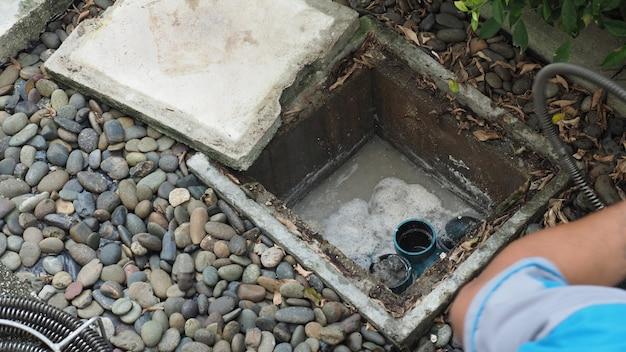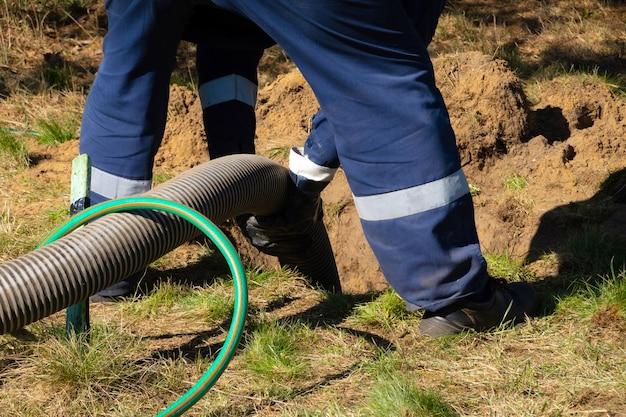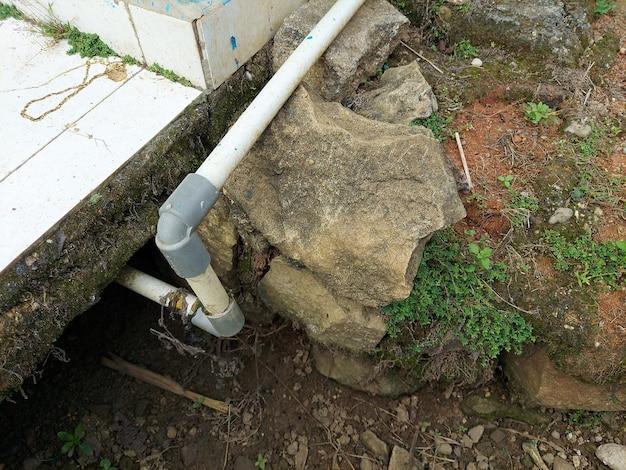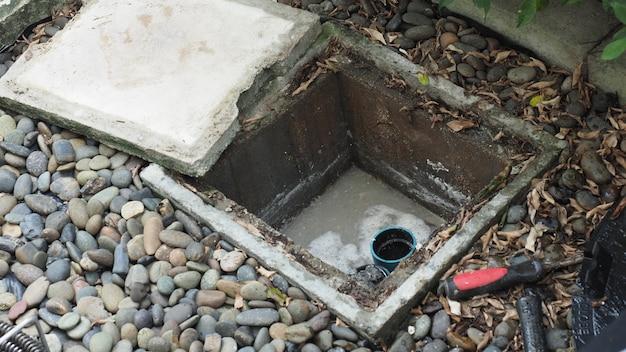Are you experiencing flooding in your basement or around the foundation of your home? A clogged sump pump outside drain could be the culprit. When your sump pump discharge line is obstructed, water can’t flow away from your home, creating a host of problems, including water damage to your property.
This comprehensive guide will provide you with all the information you need to resolve your sump pump outside drain clog and prevent it from happening again. We’ll delve into common causes of sump pump clogs, how to check the discharge line, and how to clear it of debris.
You’re probably wondering why your sump pump won’t drain and whether this is a common issue or not. We’ll explore why sump pump clogs occur and how to identify and fix them. Additionally, we’ll explain how to spot warning signs that your sump pump is about to clog and what you can do to prevent this from happening.
So, roll up your sleeves and prepare to get your hands dirty as we dive into how to clear a sump pump outside drain clog. Whether you’re a seasoned DIYer or a novice homeowner, we’ve got all the information you need to get the job done.
Sump Pump Outside Drain Clogged
If you have a sump pump and an outside drain, the last thing you want is for them to clog. If either one becomes clogged, it can cause water to back up into your home, causing damage and potentially costly repairs. Here are some things to consider if your sump pump outside drain is clogged.
Signs of a Clogged Sump Pump Outside Drain
One of the first signs of a clogged sump pump outside drain is that water no longer flows freely through the drain. If you notice water backing up into your basement or the area around the drain is excessively wet, there is a good chance the drain is clogged.
Causes of Sump Pump Outside Drain Clogs
There are several reasons why a sump pump outside drain can become clogged. Dirt, leaves, and other debris can accumulate in the drain over time, especially if the area around the drain is not kept clean. Another cause may be tree roots growing into the drain over time.
How to Unclog a Sump Pump Outside Drain
If your sump pump outside drain is clogged, the best approach is to call a professional plumber to assess the situation. Trying to unclog the drain yourself may cause further damage to the drain or the sump pump system.
Preventing Future Clogs
Preventing future clogs to your sump pump outside drain can be as simple as keeping the area around the drain clean and free of debris. Regular maintenance of the sump pump system can also help prevent clogs from occurring.
A clogged sump pump outside drain is a problem that requires immediate attention. By being aware of the signs of a clogged drain, understanding the causes, and taking preventative measures, you can help keep your sump pump outside drain in good working order and protect your home from potential water damage.
Why Isn’t My Sump Pump Draining Properly
If you have a sump pump installed in your basement, it is essential to keep it adequately maintained and functioning. However, if you notice that your sump pump is not draining correctly, you may be facing an emergency situation that needs to be addressed immediately. In this section, we will discuss some of the possible reasons why your sump pump may not be draining correctly.
Blockage in the Drainage Pipes
One of the most common reasons why a sump pump may not be draining is due to a blockage in the drainage pipes. This can happen due to various reasons, such as the accumulation of dirt and debris in the pipes or due to the growth of tree roots. In such cases, the best remedy is to call a professional plumber who can help you remove the blockage and repair any damaged pipes.
Sump Pump is not Installed Correctly
If your sump pump is not draining correctly, it may be because it’s not installed correctly. For instance, it could be that the pump is not at the right height, the pipes are not angled correctly or that there is no check valve installed. Such issues can cause water to flow back into the sump pit, thereby defeating the purpose of having a sump pump. It is best to have a professional plumber inspect your sump pump to ensure everything is in order.
The Sump Pump is not Powerful Enough
Another reason why your sump pump may not be draining correctly is the pump’s power. If the motor is underpowered, it may not be able to handle a large influx of water. As a result, water will accumulate in the pit, causing the sump pump to cycle on and off continuously. This may also cause the sump pump to wear out quickly. In such cases, your best option is to replace the sump pump with a more powerful one.
In summary, a sump pump is a crucial investment for any homeowner with a basement prone to flooding. Maintenance is key to ensuring that it works efficiently. If you notice that your sump pump is not draining correctly, do not hesitate to contact a professional plumber immediately. Remember that a malfunctioning sump pump can lead to costly damages to your home.
Sump Pump Clogged with Sediment
When it comes to sump pumps, one of the most common issues homeowners face is a clogged pump due to sediment buildup. This can cause water to accumulate in your basement, leading to flooding, mold growth, and other costly damages. In this section, we’ll discuss what causes sediment buildup in your sump pump and what you can do to prevent it from happening.
What Causes Sediment Buildup in Your Sump Pump
Over time, sediment can accumulate in your sump pump due to a variety of factors. These can include:
- Dirt and debris: As water flows into your basement, it can bring dirt, rocks, and other debris that can settle in your sump pit and be carried into your pump.
- Iron and mineral buildup: In areas with hard water, minerals like iron and calcium can build up in your pump and create sediment.
- Age: As your sump pump gets older, it can become less efficient at removing water, which can lead to sediment buildup.
- Poor maintenance: Neglecting routine maintenance like pump cleaning and inspection can allow sediment to accumulate unchecked.
How to Prevent Sediment Buildup in Your Sump Pump
Preventing sediment buildup in your sump pump is crucial to ensuring it works effectively and protecting your home from water damage. Here are a few tips to keep your pump running smoothly:
- Regular cleaning: To prevent sediment buildup, you should clean your sump pump regularly, ideally once a year or more frequently if you live in an area with hard water or heavy rainfall.
- Install a sediment filter: A sediment filter can help prevent debris and minerals from entering your sump pump. These filters are easy to install and can extend the life of your pump.
- Upgrade your sump pump: If your pump is getting old or is constantly clogging, it may be time to replace it with a newer, more efficient model. Look for pumps with advanced features like automatic shut-off and battery backup to ensure your home stays protected even during power outages.
In conclusion, sediment buildup is a common problem that can significantly reduce the efficiency of your sump pump. By taking proactive measures to prevent sediment buildup, you can keep your pump operating at optimal levels, ensuring your home stays dry and safe during heavy rainfall and floods.
How to Check Sump Pump Discharge Line
When your sump pump is running, it’s crucial to ensure that the water is being properly discharged from your house. Checking the sump pump discharge line is an essential step in keeping your basement dry, especially during the rainy season. Here’s how you can check your sump pump discharge line:
Step 1: Locate the Discharge Line
The sump pump discharge line is typically located outside your house and is a PVC pipe that runs from the sump pump to the outdoors. Look for a small white pipe, approximately 1 1/2 inches in diameter, that protrudes from your house’s foundation.
Step 2: Check for Clogs
Ensure the PVC pipe is free of debris and clogs. Clogs are usually caused by debris such as mud, leaves, rocks, or ice, which can prevent the water from being pumped outside. In case you notice a clogged pipe, clean the pipe by removing the debris manually.
Step 3: Check the Exit Point
The sump pump discharge line should be discharging water away from your house, preferably towards a drain or a safe area. Ensure that the water is flowing out of the end of the pipe.
Step 4: Test the Pump
Test the sump pump by pouring water into the sump basin. Make sure the pump turns on and discharges water through the PVC pipe. If the pump fails to turn on or discharge water, call an expert to inspect and repair the pump.
Keeping your sump pump discharge line free from clogs and checking its performance regularly is critical to preventing water damage to your home. By following these easy steps, you can ensure that your sump pump is working correctly and keeping your basement dry.
How to Drain Sump Pump Away from House
During heavy rainfall, your sump pump can help keep your basement from flooding by removing excess water and redirecting it away from your home’s foundation. However, if the sump pump’s outside drain becomes clogged with dirt or debris, it can lead to water pooling near your home or even seeping into your basement. To prevent this, here are some steps you can take to drain the sump pump away from your house.
Extend the Discharge Line
First, make sure your sump pump’s discharge line is long enough to carry water far away from your foundation. If the discharge line is too short, the water may flow right back toward your home and cause even more problems. You can purchase extension kits at most hardware stores to lengthen the line and redirect the water to a more suitable area.
Install a Dry Well
A dry well can also help drain the sump pump away from your house. A dry well is essentially a large hole filled with gravel that absorbs water and distributes it into the soil. To install a dry well, dig a hole several feet deep and wide enough to accommodate your sump pump’s output pipe. Fill the hole with gravel and install a drainage cap on top to prevent debris from entering. Then, attach your sump pump’s output line to the top of the drainage cap with a PVC pipe.
Create a Slope
Another way to direct water away from your foundation is to create a slope in the soil around your house. The slope should be at least 1 inch per foot, with the highest point around your home’s foundation. This will ensure that water flows away from your home instead of toward it. You can use a shovel and rake to adjust the soil’s grade and create the desired slope.
In conclusion, it’s essential to keep your sump pump’s outside drain clear to prevent water damage to your home. By following these simple steps, you can easily drain the sump pump away from your house and keep your basement dry. Remember, it’s best to consult with a professional if you’re unsure of any steps in the process to avoid causing more significant issues.
Why is My Sump Pump Overflowing Outside
If you’re experiencing a situation where your sump pump is overflowing outside, then you’re probably wondering what could be causing the issue. There are several reasons why your sump pump might be overflowing, and we’ll cover them here in this blog post.
Insufficient Pump Size
One of the most common reasons for sump pump overflow is that the pump is not big enough to handle the volume of water coming in. Sump pumps come in different sizes, and you must ensure that the size of your pump matches the volume of water it’s expected to handle. If you’re experiencing frequent overflow, you should consider upgrading the pump to a bigger size.
Clogged or Frozen Discharge Pipes
Another possible cause of sump pump overflow is a clogged or frozen discharge pipe. The discharge pipe is responsible for transporting water from the sump pump to the outside of the property. If this pipe is clogged with debris or frozen, it can cause water to backup and overflow. Ensure that the discharge pipe is free of clogs and debris.
Improper Pump Installation
If your sump pump is not installed correctly, it can cause water to overflow. The pump should be installed at the lowest point of the pit, and the float switch must be properly adjusted, or else it can lead to the pump running continuously. It’s important to hire professionals for the installation of sump pumps.
Damaged or Malfunctioning Pump
A damaged or malfunctioning pump can also lead to sump pump overflow. If the pump is not functioning correctly, it won’t be able to pump out the water effectively, and this can cause the water to overflow. Conduct regular maintenance on your sump pump to identify any issues before they become a problem.
In summary, sump pump overflow can be caused by several factors such as insufficient pump size, clogged or frozen discharge pipes, improper pump installation, or damaged/malfunctioning pump. To mitigate overflow issues, ensure that the pump is installed correctly, conduct regular maintenance checks, and replace the pump if it’s not functioning correctly.
Should There Be Standing Water in Outside Drain
If you have a sump pump outside drain, you may run into the issue of standing water, which can be overwhelming, especially during heavy rainfall or storms. So, should there be standing water in an outside drain, or is it a sign of a problem? In this subsection, we will explore the reasons why outside drains may hold standing water and what remedies are available.
Clogged Drain
One of the primary reasons why an outside drain may have standing water is due to clogs. Dirt, debris, and leaves can collect in the drain, creating a barrier that prevents water from flowing freely. When this happens, you may notice that water accumulates around the drain. A simple solution to this problem is to remove the debris and clear the clog. You can do this either manually or using a wet-dry vacuum.
Blocked Sewer Line
Besides clogs, standing water in an outside drain may indicate a more severe problem, such as a blocked sewer line. In this case, the water may be accumulating as a result of blockages in the sewer line, causing it to back up into your sump pump outside drain. If you suspect that this is the problem, it’s best to seek professional help to diagnose and fix the issue before it gets out of hand.
Incorrect Installation
Another factor that could cause standing water in outside drains is incorrect installation. If the drain was not installed with the correct slope, the water may not flow properly, leading to standing water. You can rectify this by re-installing the drain or seeking help from a professional to do it for you.
Having standing water in your sump pump outside drain can be a nuisance, but it can also indicate other issues. Understanding the reasons why there is standing water in your drain can help you take the right steps to fix the problem. However, if you’re unsure of the cause, or the problem seems more than what you can handle, don’t hesitate to seek help from a professional.
How to Tell if Your Sump Pump Discharge Pipe is Clogged
If you have a sump pump installed on your property, it’s essential to ensure that it is in good working condition. One of the most common problems associated with sump pumps is a clogged discharge pipe. If the pipe is clogged, it can prevent the pump from functioning correctly, leading to flooding and other water damage issues. Therefore, it’s crucial to know how to tell if your sump pump discharge pipe is clogged. Here are some signs to look out for:
Water Flow
The first and most obvious sign of a clogged sump pump discharge pipe is that water does not flow freely out of it. When the sump pump is activated, water should be pumped out of the pit and discharge through the pipe. If the pipe is clogged, the water will not flow out or will only trickle out slowly.
Strange Noises
A clogged sump pump discharge pipe can cause the unit to make strange noises. As the pump tries to push water through the pipe, it may produce rattling, gurgling, or grinding sounds. The noises will likely be louder than usual and may be accompanied by vibrations.
Pump Motor Overheating
A sump pump with a clogged discharge pipe may cause the pump motor to overheat. When the pump works harder than it should, the motor will heat up, leading to damage and the eventual failure of the pump.
Increased Humidity
If the sump pump discharge pipe is clogged, water will remain in the sump pump pit, increasing the humidity levels in your basement or property. You may notice a musty smell, mold growth, or peeling paint, and increased humidity may also damage wood and cause structural problems over time.
In summary, it’s essential to be vigilant and observe your sump pump’s functionality to ensure it’s working correctly. Keep an eye out for any signs of a clogged discharge pipe, such as reduced water flow, strange noises, overheating pump motor, and increased humidity levels. If you are experiencing any of the above issues, it’s advisable to engage a professional plumber to inspect your sump pump and take proper remedial action.



